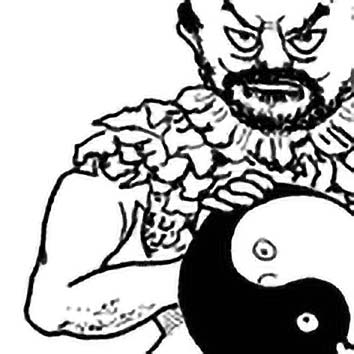PAN GU
Chinese Creator God
Also known as P'an-Ku, Pangu

Giant Creator God born of the Cosmic Egg
In the beginning, the Universe was like a huge black egg floating in the void. (Who laid the egg? We don’t know. Our researches have so far failed to uncover a Cosmic Chicken.)
Trapped inside the egg was Pan Gu, by all accounts a hairy, shaggy critter. He had been sleeping for 18,000 years and was now looking forward to stretching his legs. Grabbing a handy axe, he bashed open the shell and watched in amazement as the Universe formed around him.
The light and lissom egg white floated serenely upwards and became the Heavens. The yolk, being heavier and rather lumpy, plummeted downwards and became the Earth.
Pan Gu thought this was wonderful, but what if the Heavens should fall or the Earth rise? The resulting Scrambled Cosmos was more than he could bear, so he resolved to stand between and hold the two apart like a Chinese Atlas.
Now Pan Gu was a growing lad, becoming taller with each passing year. At the rate of about three meters per day, after another 18,000 years he’d grown to almost 30,000 kilometers in height. This is roughly the circumference of the Earth, and Heaven was now so far up there was no danger of it ever falling to Earth again.
His mission accomplished, an exhausted Pan Gu expired. His last breath became the wind, his sweat became the rain, his voice became the rumbling of thunder — and the rest of him was put to equally productive use.
Some legends tell that the fleas infesting his shaggy fur dropped to Earth and became the ancestors of the human race. But you can’t believe everything you hear as Nu Gua also claims responsibility.
Pan Gu Facts and Figures
Name: Pan Gu
Pronunciation: Parn Goo
Alternative names: P'an-Ku, Pangu
Gender: Male
Type: God
Celebration or Feast Day: Unknown at present
Role:
In charge of: Creating
Area of expertise: Creation
Good/Evil Rating: Unknown at present
Popularity index: 11872
Cite this article
Here's the info you need to cite this page. Just copy the text in the box below.
Article last revised on September 25, 2018 by Rowan Allen.
Editors: Peter J. Allen, Chas Saunders
References: Coming soon.